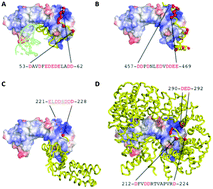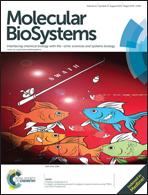Structural D/E-rich repeats play multiple roles especially in gene regulation through DNA/RNA mimicry†
Abstract
Aspartic acid and glutamic acid repeats in proteins exhibit strong negative charge distribution and they may play special biological roles. From 39 684 unique structural data in the RCSB Protein Data Bank (PDB), 173 structures were found to contain ordered D/E-rich repeat structures, and 57 of them were related to DNA/RNA functions. The frequency of occurrence of glutamic acid (36.90%) was higher than that of aspartic acid (27.02%). Glycine (2.38%), alanine (2.68%), valine (3.54%), leucine (5.57%), and isoleucine (3.34%), but not methionine (0.91%), were the most abundant hydrophobic residues. The available complex structures suggested that D/E-rich proteins might be involved in DNA mimicry, mRNA processing and regulation of the transcription complex. The region surrounding the D/E-rich repeat sequences plays important roles in the binding specificity toward the target proteins. The numbers and composition of aspartic acid and glutamic acid might also affect binding properties. Aspartic acid and glutamic acid are disorder-promoting residues in the intrinsically disorder proteins. Our findings suggest that the D/E-rich repeats are unique components of intrinsically disordered proteins, which are involved in the gene regulation and could serve as potential druggable fragments or drug targets.


 Please wait while we load your content...
Please wait while we load your content...